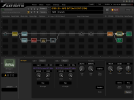Greg Ferguson
Legend!
Remember that it doesn’t matter what you listen through, that when you are auditioning presets and setting your EQ, your volume needs to be 90-100 dB to defeat the Fletcher-Munson effect. In addition, unless you are confident that the speakers or headphones are flat you still need to compensate for their own particular EQ curve. Also, unless you’re wearing headphones your room needs to be treated and the speakers positioned properly.Would anyone be able to help me analyze this? Im recently becoming more and more sensitive to the eq differences between my listening devices. Im attaching links so y'all can see the frequency responses. Out of all 3, I like the iLoud Micro Monitors the best. They have the smoothest tone; with these I dont notice any highlighted frequencies when Im playing my guitar in isolation. My Shure SE535's sound great when I use them live with my band. I guess theyre able to carry a full mix well and still let my guitar come through for me. When I use them for practicing in isolation or with tracks, I hear something that dulls my tone or my attack. It's like I have to pick harder to work for notes. With my Beyerdynamic DT770's, it's even worse. Idk what it is, but they dull my tone alot and make it very flat to my ears. Can anyone explain why? Im not sure what im looking at with these frequency responses and what they ultimately mean.
iLoud micro monitors:
https://www.ikmultimedia.com/products/iloudmm/index.php?p=specs
Shure se535
https://reference-audio-analyzer.pro/en/report/hp/shure-se-535.php#gsc.tab=0
Beyerdynamic DT770
https://reference-audio-analyzer.pro/en/report/hp/beyerdynamic-dt-770-pro-80.php
I have two pair of the SE535 Red, and they are awesome earphones, but I don’t often use them for EQing. They sound amazing when watching movies, as if I’m in a THX auditorium, but I am not quite happy with the compensation curves or IRs when working with the modelers.
My DT770 get a lot more use, either with the compensation curve or IR, depending on which unit I’m working with.
I just got the OLLO S5X, and really like how the presets sound through them without any compensation.




